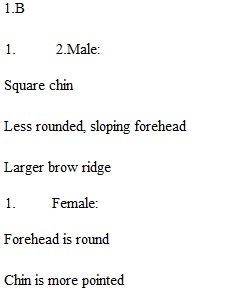


Q Question 1 1 / 1 pts (Q001) Review the traits used for estimating biological sex from the cranium and the pelvis in the tables on p. 188 and p. 189 of your lab manual. Use the images in the Lab 7 Exercise Image Library on p. 219 of your lab manual to complete the following exercise. PART A Estimate the sex of the three crania depicted on p. 219 of your lab manual and fill in the chart on p. 208 of your lab manual. For each cranial feature on the list, score it as either M, F, or ? (if you are unsure or the feature is not visible). Compare the crania with one another or the crania depicted in Figure 7.6 (on p. 186 of your lab manual). Once you have completed the chart, tally the total number of Ms and Fs for each cranium and determine the estimated sex. Which cranium is female? Question 2 1 / 1 pts (Q002) Describe two cranial sexing traits you used to make this determination. Question 3 1 / 1 pts (Q003) PART B Estimate the sex of the two pelvises in the chart on p. 209 of your lab manual. For each pelvic feature on the list, score it as either M, F, or ? (if you are unsure or the feature is not visible). Compare the three pelvises with one another or the pelvises in Figure 7.7 (on p. 188 of your lab manual). Once you have completed the chart, tally the total number of Ms and Fs for each pelvis and determine the estimated sex. Which pelvis is female? Correct!
View Related Questions